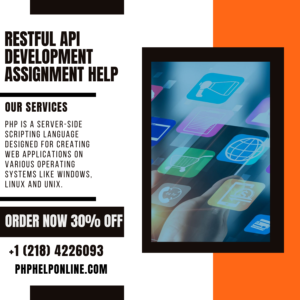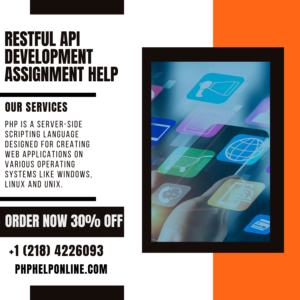Which website can complete my RESTful API homework on API versioning and change management strategies?
Which website can complete my RESTful API homework on API versioning and change management strategies? ====== jssdins Yes and no!

 PHP is an incredible and flexible programming language with numerous advanced features, RESTful API Development Assignment Help yet for beginners it may be challenging to fully leverage all its potential.
PHP is an incredible and flexible programming language with numerous advanced features, RESTful API Development Assignment Help yet for beginners it may be challenging to fully leverage all its potential.
An API (Application Programming Interface) is a set of rules governing how software applications interact and communicate, providing developers with a flexible tool for building and testing apps in distributed environments.
APIs connect software applications with back-end servers in order to transfer data and functionality, often through RESTful APIs that use REST-style techniques. RESTful APIs are generally more scalable and flexible, and can be utilized across platforms or client technologies without issue; however, before developing one it’s essential that one understands its limitations.
An effective RESTful API should provide an accessible and uniform experience for every client who interacts with it, Security In Web Assignments without which any disparate requests and responses could lead to information being misplaced, rendering applications incapable of functioning effectively.
Lastly, an API should support a standard data format such as JSON to facilitate development faster and provide error messages in human-readable form when problems arise – this makes debugging and testing much simpler for developers. Furthermore, stateless APIs prevent servers from maintaining state between calls which could otherwise cause complications.
REST APIs use HTTP to communicate with client software and define a set of constraints for developers who create web services using REST, including layer architecture, statelessness and caching.
RESTful APIs feature a multi-layered structure, which enables clients to store frequently used information locally on their computers; this reduces server calls and improves performance while simultaneously allowing servers to cache response data.
RESTful APIs also employ various headers to provide additional details. For instance, API Performance Optimization the GET request could include an Accept header which identifies the format of data being requested – helping the server determine whether or not an entry should be considered appropriate.
Similarly, the If-Modified-Since header indicates when a resource was last updated; this allows servers to avoid sending outdated information back out to clients and caching. Furthermore, RESTful API allows servers to specify how long responses should remain stored before being served again.
REST architecture makes communicating with servers easier for web or mobile apps thanks to HTTP headers that provide information on resources such as their availability status and names of their procedures. Compared with RPC architecture which requires developers to be familiar with procedure names and arguments in a specific order, REST makes this interaction simple due to HTTP headers providing details on a resource.
Clients can request any resource from the server using any one of the HTTP methods supported, such as GET, POST and DELETE. For example, accessing /users/:id will retrieve user data from the database level; updating attributes would need to be performed for every request that targets that user ID; API Security Measures while a request to /users/:id/:id/delete_user would delete one permanently from the database level.
Testing a REST API is important, as it enables developers to assess its functionality, security and performance as well as ensure its design follows an optimal path. Therefore, it should be performed under similar working conditions that would mimic its intended working capacity, with HTTP response header analysis to make sure they match up with expectations set by developers.
To make your API easy to use, it is crucial that it has proper documentation. This may include references, guides and examples. Ideally, this documentation should provide both in-app and online help so users can quickly locate what they need quickly. It is also worth keeping an eye on how your documentation may change as new features or updates come along.
RESTful APIs feature an accessible, uniform interface that makes communication between applications simpler. This is because each layer in the system serves a specific function – Release Management Strategies making sure that changing one component won’t lead to unexpected consequences in other areas of operation.
Standard HTTP methods (GET, PUT and DELETE) and URIs are employed to identify resources. Furthermore, hypermedia technology enables dynamic interactions between client and server via stateless interactions allowing stateless interactions that reduce operational costs and delays as well as provide stateless interactions that enable stateless interactions which reduce operational costs and delays further. In addition, RESTful API is both scalable and maintainable which is especially important in logistics where reliable delivery and tracking of packages is vitally important.
 Hiring REST API developers requires professionals who possess RESTful API Versioning an in-depth knowledge of HTTP. This screening test tests candidates’ understanding of this protocol in terms of real world usage.
Hiring REST API developers requires professionals who possess RESTful API Versioning an in-depth knowledge of HTTP. This screening test tests candidates’ understanding of this protocol in terms of real world usage.
REST API developers must understand how to make GET, PUT and DELETE calls as well as respond to HTTP response codes appropriately.
PHP is a programming language commonly used for creating dynamic or static websites and applications on the World Wide Web. As a server-side scripting language combining syntax from other languages such as C and Java, PHP can easily create websites and applications of all kinds ranging from static pages to dynamic apps that meet any business need. PHP can easily be learned and has an expansive community of developers who understand its syntax.
REST APIs offer numerous advantages, from data transfer efficiency and scalability to platform-agnostic communication. To take full advantage of them, Compatibility Best Practices an API developer needs the appropriate skills: knowledge of REST architectural style as well as designing intuitive URIs, selecting data formats and documenting API functionality are just some of these considerations.
An API developer is an invaluable resource in today’s technological environment, offering businesses innovative and effective solutions that benefit from this skill. Toptal offers freelancers who possess advanced REST API development expertise as potential solutions.
Server-side languages run on servers and enable user input and content generation, reading/writing data, processing client side code, as well as pagination so only relevant information is returned for any given request. A good developer of a server-side language should be capable of building robust APIs that support multiple data formats and languages while also offering pagination features so as to only return manageable amounts of information when responding to requests.
REST API developers specialize in crafting APIs that provide scalability, Best Practices And Tools efficiency and interoperability between systems. Their designs adhere to REST architectural style’s six principles of Uniform interface, Client-server architecture, Statelessness, Cacheability Layered system and Code on demand. Furthermore, REST developers know how to design intuitive URIs, choose data formats and set up development environments efficiently as well as versioning tools that enable them to revert back to previous versions if necessary.
A scripting language is a software programming language designed to add additional functionality in computer environments, typically used for automating repetitive tasks that would otherwise need to be done manually by human operators. A scripting language is often embedded into other environments like software apps or browsers and executed at runtime – unlike programming languages which compile their code into machine-readable form prior to interpretation at runtime.
RESTful APIs offer a powerful yet straightforward method for developing scalable web service interfaces. Their central architecture relies on HTTP methods for access, while mobile RESTful API Development and web development connect directly with microservices via RESTful APIs. RESTful APIs reduce complexity while speeding development timeframes while decreasing bandwidth needs.
RESTful APIs are ideal for websites looking to scale while providing users with an enjoyable user experience. Building one requires planning and identifying resources, creating intuitive URIs, selecting data formats (like JSON), implementing CRUD operations, testing them thoroughly before testing for security risks and documenting everything thoroughly.
REST API is an accessible set of development principles that provides software developers with an efficient means of offering data to end-users. Utilizing standard technologies like JSON and XML, users are able to make calls such as GET, PUT and DELETE calls while software versioning tools like Git and SVN enable developers to track changes as they occur while reverting back to previous stable versions if needed.
REST architecture places great importance on scalability, generality and independent deployment. Furthermore, Assignments On Websites Securely intermediary components are used to reduce interaction latency while upholding security and protecting legacy systems.
Hiring REST developers can be challenging, but it is vitally important that your business finds the appropriate candidate. An ideal REST developer candidate should demonstrate strong interpersonal communication and team-working abilities as well as be knowledgeable with current tools and technologies for web development such as HTML/CSS needed for front-end development.
 PHP can be difficult for newcomers to grasp, requiring an understanding of both syntax and concepts for completion of assignments. Due to this challenge, RESTful API Development many students seek help online experts for assistance with their PHP programming assignments.
PHP can be difficult for newcomers to grasp, requiring an understanding of both syntax and concepts for completion of assignments. Due to this challenge, RESTful API Development many students seek help online experts for assistance with their PHP programming assignments.
BookMyEssay has extensive experience providing PHP assignment help to university/college level students.
Commonly embedded within HTML documents, it connects with databases and manipulates data as needed. Easy and highly flexible in use, PHP also features numerous hash functions for secure computing that protect user information.
PHP can be combined with other programming languages like JavaScript and CSS for site development purposes, while supporting MySQL, Oracle and PostgreSQL databases. Furthermore, Practice For Websites Securely its platform-independence means it can run across most major operating systems.
PHP is easy to learn and integrates seamlessly with existing CMS platforms, making it ideal for backend development projects. With its flexible code structure and support for plugins, it makes PHP an excellent choice for back-end work. Furthermore, modern programming features like namespaces, traits and type hinting have also been adopted within PHP’s programming language framework.
PHPs versatility also makes it ideal for working with various databases. An REST API developer needs to fully comprehend and document their API’s requests, responses, Website’s PHP Programming and security protocols in order to be an effective candidate for your project. Our testing tool evaluates these skills as part of this hiring test in order to help find you the ideal individual for the role.
Web developers utilize client-side scripting languages like JavaScript to give instructions that browsers can understand. This stands in contrast to server-side scripting languages like PHP or ASP that execute on webservers to generate dynamic pages with dynamic data retrieved via databases.
REST API developers are programmers who utilize the REST architectural style when developing web servers, using its layered architecture to maximize scalability, maintainability and security. Furthermore, these developers specialize in documenting requests, responses and server related matters for easy reference.
PHP can be used both server- and client-side scripting languages, providing more interactive front ends of websites seen by users and Programming Homework Online using JavaScript scripting for interactivity on front ends.
Client-side scripting languages like PHP and Javascript are interpretive, while C or c++ require compilation before running on hardware. Their performance depends on which hardware platform is being used and is an important consideration when choosing a scripting language for a project.
PHP is a server-side programming language and web development framework with an easy learning curve and implementation, working well with HTML code. With its flexible syntax, developers can create dynamic content as well as powerful e-commerce platforms with PHP.
PHP stands apart from other programming languages by being interpreted real-time by web servers, Website’s API Development making feedback much faster. Furthermore, multiple team members can maintain it easily.
Syntactically, Python resembles C, Java, and Perl; though some details differ slightly between them. Anyone familiar with programming in any of these languages should find its expressions and loops immediately recognizable in Python; furthermore it supports most major databases and servers across platforms.
Which website can complete my RESTful API homework on API versioning and change management strategies? ====== jssdins Yes and no!
Who offers reliable PHP Programming assignment services for RESTful API versioning and API gateway integration approaches? Find out what information
Where to find experts for RESTful API Development homework on API security measures and best practices for secure coding? Hi
Who can solve my PHP Programming assignment on RESTful API versioning and API rate limiting best practices? I’ve been reading
How to hire someone for RESTful API coding challenges on API performance optimization and load testing tools? I’m a SaaS
Which platform offers assistance for PHP Programming assignment on RESTful API versioning and backward compatibility techniques? Please continue this discussion
Who can provide help with RESTful API homework on API error response handling and logging best practices? Please answer this
Where to find experts for PHP Programming homework on RESTful API versioning and data validation approaches? Need some tips for
Who can assist with RESTful API Development tasks on API security measures and encryption techniques? For now, I decided to
How to get help with PHP Programming assignment on RESTful API version control and release management strategies? When problem appears
PHPHelpOnline offers expert assistance for PHP assignments, projects, and coding solutions tailored to your needs.


Copyright © All rights reserved | PHP Help Online